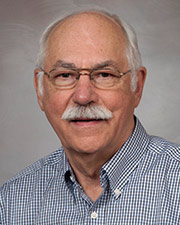Cryo-EM helps to map mitochondrial function

Research led by the Department of Biochemistry and Molecular Biology using cryo-electron microscopy has shed light on the importance of phospholipids in mitochondria function, paving further mechanistic understanding of these cell power plants.
“Structural insights into cardiolipin replacement by phosphatidylglycerol in a cardiolipin-lacking yeast respiratory supercomplex” was published this month in Nature Communications.
“The primary goal of this work was to understand the role of phospholipids in the organization of respiratory supercomplexes (SCs) in mitochondria. We purified SCs from yeast, which have similar properties to SCs from mammalian cells. Studies in yeast have the advantage of applying genetic manipulation of phospholipid synthesis in the mitochondria to perturb SC structure and function,” explained lead author William Dowhan, PhD, professor of biochemistry and molecular biology.
Cryo-EM allows the study of three-dimensional structures of biomolecules in their near native state. Structural biologists have employed Cryo-EM technology at McGovern Medical School since 2004 to understand protein nanomachines related to a variety of cell functions and diseases.
“This effort is an outstanding display of the capabilities of our Cryo-EM Core Facility and represents an important cooperative effort by the departmental faculty,” said Rodney Kellems, PhD, chair of the Department of Biochemistry and Molecular Biology.
This research provides an understanding at the structural level of the requirement of a negatively charged phospholipid for the stable assembly of individual respiratory complexes into SC molecular machines. Previous studies had suggested a diminished role for phospholipids since yeast mutants lacking the negatively charged mitochondrial lipid cardiolipin (CL) still formed SCs. This work demonstrated the presence of the anionic phospholipid phosphatidylglycerol at all CL positions in the yeast SC isolated from yeast mutants lacking CL thus establishing a requirement for such phospholipids.
Reduced CL levels result in a broad range of pathological alterations in human mitochondrial function associated with neurodegenerative diseases, ischemia followed by reperfusion, induction of apoptosis, heart failure, cancer, Barth Syndrome, hypothyroidism, obesity, and aging.
Additional authors from the Department of Biochemistry and Molecular Biology include Corey Hryc, Venkata Mallampalli, Evgeniy Bovshik, Stavros Azinas, Guizhen Fan, Irina Serysheva, Matthew Baker, and Eugenia Mileykovskaya, and Genevieve Sparagna at University of Colorado Anschutz Campus.